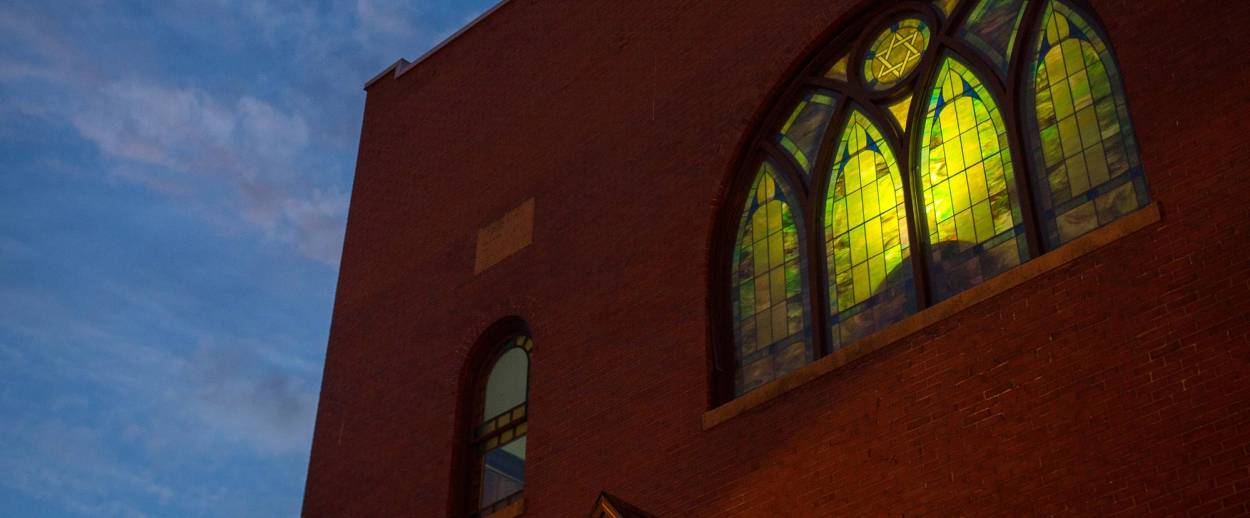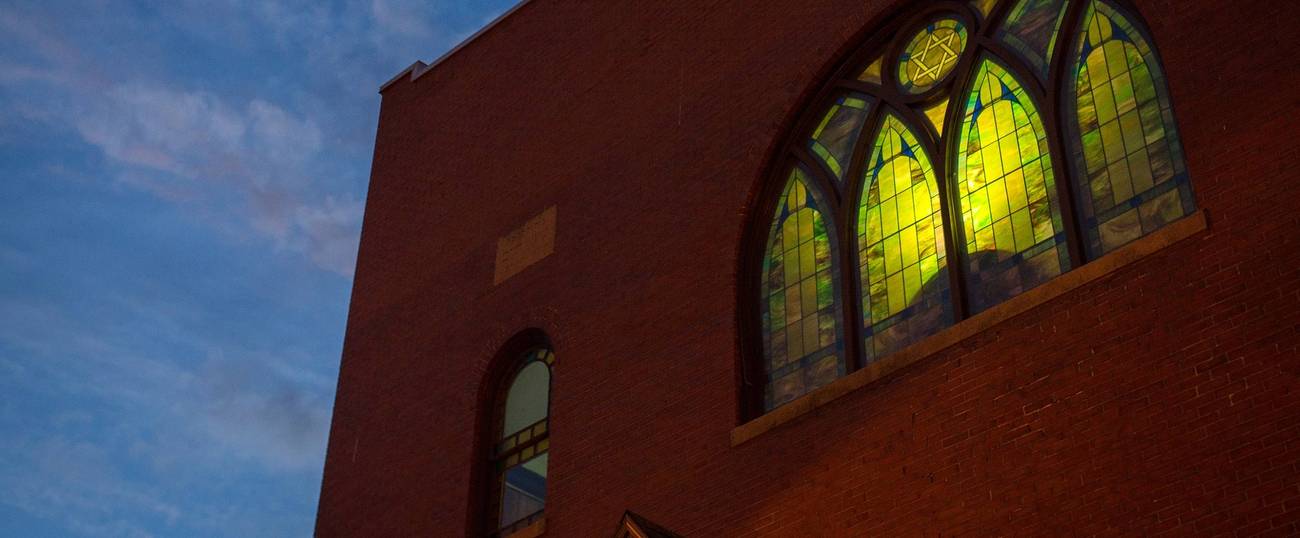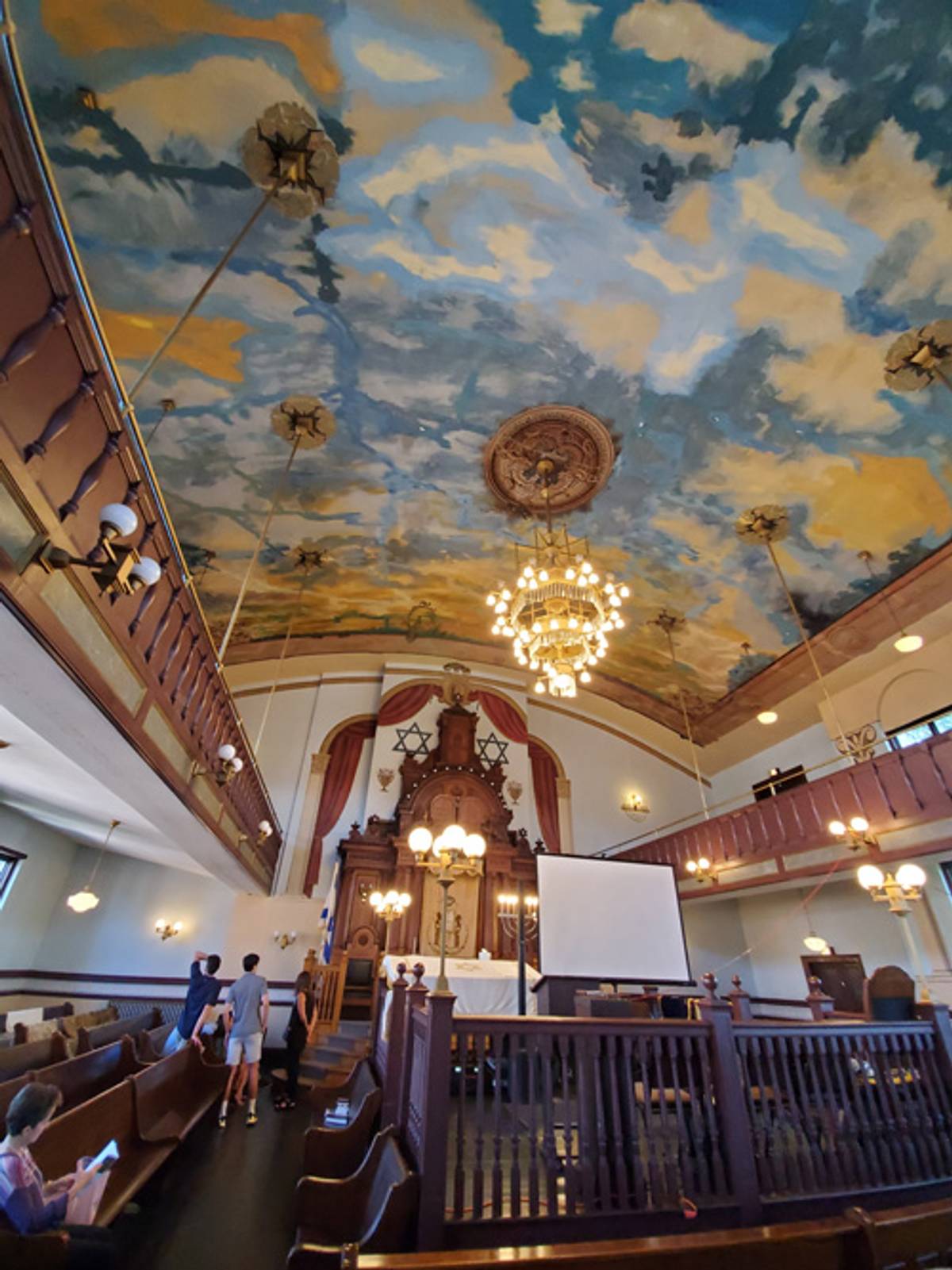A Synagogue’s Second Act
Around the country, shuls facing declining attendance are being converted into museums and cultural centers




“We have come to Chelsea,” Louis D. Brandeis told a large crowd gathered on Wednesday, June 30, 1915—a year before he was appointed to the U.S. Supreme Court. Brandeis had delivered one of his earliest speeches on Zionism two years earlier in this Massachusetts city. And now, in 1915, as leader of the Federation of American Zionists, he had moved the group’s national convention out of Boston for one day, across the Mystic River to Chelsea. “We have come because, in Chelsea, Jews constitute a larger percentage of the population than in any other city of the United States,” Brandeis announced.
Once nearly 50% Jewish, with more Jews per square mile of any U.S. city outside of New York, Chelsea played a significant role in 20th-century American Jewish life. Kosher butchers, Jewish bakeries, and more than 18 synagogues were located within a 1.8-square-mile area, from the early 20th century until the 1970s, when the Jewish population had dwindled due to suburban migration. This working-class city four miles north of Boston is now 65% Latino, and bodegas, panaderías, and Hispanic churches line its narrow streets.
This September, the Walnut Street Synagogue, Chelsea’s only surviving Orthodox shul, celebrated its Founders’ Day. More than 250 attendees—including descendants of shul founders, Chelsea City Council members, former Chelsea residents, and Jewish community representatives—came to honor the shul’s legacy. For some descendants, like 88-year-old Helene Kress, who grew up in Chelsea, it was a nostalgic trip back to childhood. Others hoped to discover their roots, like Helaine Kaplan, who only recently learned that her paternal great-grandfather was a founder after receiving a letter from the Founders’ Day Committee that had researched her family history.
“It is very important to save Jewish landmarks,” said Michigan resident Tom Barth, whose extended family came to honor their great-grandfather, the shul president when the building was dedicated in 1911.
“Its size and grandeur made it the preeminent shul in Chelsea, and worthy of everyone’s efforts to preserve and restore it,” said Carol Clingan, a local genealogist, who spent a year tracking down and reaching out to founding members’ descendants, beginning with a list of 160 Yiddish names, to invite to the event.

But the Founders’ Day gathering wasn’t just about honoring the synagogue’s past; it was about planning for its future. Most members live outside of Chelsea, are over 60, and monthly Shabbat services generally attract fewer than 30 worshippers. It has become a struggle to pay bills, maintain, and heat this large, century-old structure.
“I realized I was entrusted with going forward with an historic building, with a city that loves the synagogue, but there are not many Jews left,” explained synagogue President Ed Medros, whose proposal to transform the synagogue was accepted by the Board of Directors in 2017. “We need to look ahead to the future, attract new blood, and make sure that the building survives.”
As discussed at the Founders’ Day event, the shul plans to transform itself into the Chelsea Jewish Museum and Cultural Center at the Walnut Street Synagogue—following the example of other historic U.S. synagogues that have successfully adapted themselves for 21st-century audiences. Like congregations from New York City to Tucson that have successfully converted old synagogues into museums and cultural centers, the Walnut Street Synagogue hopes to broaden its reach to a wider audience and preserve a slice of Jewish immigrant history.
The Walnut Street Synagogue, a four-story majestic structure listed on the National Register of Historic Places since 1993, stands at the corner of 4th and Walnut streets, formerly the demographic center of Chelsea Jewish life. Its magnificent 1,109-seat sanctuary houses one of the country’s few remaining arks made by Ukrainian-born woodworker Sam Katz, beside which is a painted curtain. An original ceiling painting by an unknown, presumably Jewish artist depicts the heavens, and is a rare remaining example in an American synagogue of a trompe l’oeil technique.
The shul’s beit midrash, or study hall, houses an extensive collection of historical and religious artifacts from Chelsea and neighboring communities where synagogues have closed. Among the display items are a halitza shoe used in levirate marriages, a mizrah (an artistic wall plaque marking the eastern wall), and numerous Yiddish signs, posters, and news clippings chronicling 20th-century Jewish life in Chelsea.
Moving forward, several hurdles must be overcome before the building is converted. Final costs will be determined after the shul receives its architectural firm’s report, which will cover structure/design issues and how to make the building handicapped-accessible. The strategic plan and capital campaign also must be finalized. The shul is concurrently working with the Boston Jewish federation to identify young Jewish professionals who have moved to Chelsea because of its attractive real-estate prices—and who can help jump-start the transformation process.
The vision: In two years a cultural center/museum will open to visitors on weekdays, while synagogue services will take place on Shabbat and holidays. The basic layout and functionality will remain the same, with the 100-seat chapel in the beit midrash used for Shabbat services and the large sanctuary with the Katz ark on the High Holidays, which now draw as many as 100 worshippers. Prospective visitors—Boston-area tourists, college students, and others interested in historic architecture, American Jewish history, and culture—will be able to tour the sanctuary and view the museum’s artifacts. The shul’s ongoing partnership with the Chelsea Collaborative will present cultural programs for the local Latino population, similar to a concert of Latin American music performed there two years ago. The shul also plans to work with Boston Jewish organizations to hold lectures, film festivals, and other programs in its huge sanctuary, one of the largest in New England.
“It’s a great way to bring the history of the previous century to now and to bring together the descendants of those families who founded the shul, for those people who grew up in Chelsea,” said Norman H. Finkelstein, a historian and book author who grew up in Chelsea. “Chelsea was such a tight-knit community that everybody knew everybody else. Its history provides a sense of completion that you are coming to recognize how Jewish Chelsea evolved.”
*
A few miles from Chelsea in the historic Beacon Hill section of Boston is the Vilna Shul, the last remaining “immigrant-era” shul in downtown Boston. It had sat empty for a decade until the nonprofit Vilna Shul, Boston’s Center for Jewish Culture, purchased the building in 1995. Since 2008, the center has hosted concerts, speakers, films, Jewish life-cycle events, and egalitarian Kabbalat Shabbat and High Holiday services. An interactive exhibit on the immigration history of Boston is scheduled to open in December. “The Vilna Shul is about continuity, honoring the past, and creating a link to the future through excellent programming and cultural events,” said Marilyn Okinow, shul president. And the past it honors isn’t exclusively Jewish.
Next spring, the Vilna Shul will mark 100 years at its current location. Its previous home, a few doors down the street, was previously the Twelfth Baptist Church—the house of worship of the African American soldiers of the 54th Regiment Massachusetts Volunteer Infantry led by Colonel Robert Gould Shaw during the Civil War. The church’s 19th-century wooden pews, now in the Vilna Shul’s sanctuary, are being restored along with hand-painted, decorative multilayer murals depicting biblical scenes.
The Vilna Shul is a stop on Boston’s Black Heritage Trail because of the historic connection to the African American community that lived on Beacon Hill—a center of abolitionist activity and an important stop on the Underground Railroad. “Beacon Hill is Boston’s historic neighborhood. This is the only synagogue remaining from that era—and I have a historic connection,” said Gilbert Winn, a board member whose great-grandparents were founding members. His great-grandmother, Esther Winitsky, belonged to the Women’s Auxiliary, which purchased from a furniture catalog an armoire that became the Aron Ha-Kodesh standing today in the sanctuary.
*
Across the U.S., historic synagogues have become Jewish cultural centers and museums, breathing new life into dilapidated shul buildings with few worshippers—preserving for posterity the stories of 20th-century American Jewish immigrants and the neighborhoods where they settled, while adding contemporary artistic, cultural, and social justice twists.
“We believe that stories matter, that Jewish stories matter, that Jewish stories are American stories,” said Tracie Guy-Decker, deputy director of the Jewish Museum of Maryland in Baltimore, which was founded in 1960 to rescue and restore the historic Lloyd Street Synagogue, the third-oldest standing synagogue in the U.S. (although it’s no longer an active congregation). In the sanctuary are presumably original pews and a faithful reproduction of the original Aron Ha-Kodesh. There is also a 19th-century mikvah that uses water from the local Jones Falls. “The more we can understand the past and how it resonates with us now, we can learn from it and find connection,” said Guy-Decker. The museum has become a cultural center for the Jewish community and for those interested in Jewish history, traditions, and Maryland Jewish life. Changing exhibits include art, historical photos, videos, and objects reflecting daily immigrant life. Its campus also houses the restored B’nai Israel, now home to an active modern Orthodox congregation that includes area graduate students and young professionals.
The Maine Jewish Museum is housed in the restored Etz Chaim Congregation, whose sanctuary is located on the Portland museum’s second floor. In response to changing demographics, the formerly Orthodox congregation became nonaffiliated and egalitarian when the museum was founded in 2010—a decision that has resulted in significantly increased membership (from 15 families in the 1990s to nearly 300 families today). The museum is home to a permanent exhibition on Maine Jewish history. “We were created to celebrate the lives of people who came here in the 1880s and toughed it out in the parts of Maine which were not friendly to Jews,” said Gary Barron, the museum’s executive director. The museum is now a venue for a changing roster of contemporary art exhibits featuring Jewish-connected and Maine-connected artists, as well as a permanent photo exhibit of Holocaust survivors who settled in Maine. Today the museum, ranked No. 15 on TripAdvisor’s list of top Portland attractions, receives 20,000 visitors annually.
The legacy of Joseph Gumbiner, a civil rights leader and former rabbi of Temple Emanu-El, informs the mission of the Jewish History Museum & Holocaust Center in Tucson, which is housed in the oldest synagogue in Arizona (the original home of Temple Emanu-El). Executive Director Bryan Davis said that the museum, which attracts approximately 12,000-15,000 visitors annually, tries to connect Jewish history to that of other marginalized groups such the LGBTQ community, Rohingya Muslims in Myanmar, and migrants on the U.S. southern border.
The Museum at Eldridge Street in New York City is housed in the restored Eldridge Street Synagogue, a magnificent National Historic Landmark built in 1887 and the only remaining vestige of Jewish life on New York City’s Lower East Side. “It is important for people to remember the stories associated with these buildings and the lives that were changed because of these buildings,” said Executive Director Bonnie Dimun. The Museum at Eldridge Street offers numerous cultural, educational programs and special events, including tours in 10 languages for its 40,000 annual visitors from across the globe—including many who have never before visited a synagogue. In 2020, a series of programs honoring women will commemorate the 100th anniversary of women’s suffrage.
These historic places tell the still unfolding American immigration story. Some focus exclusively on Jewish immigration, while others on the broader immigrant experience. Often, as the only remaining trace of neighborhoods where Jewish life once flourished, they provide an important historical record for future generations.
These transformations are not without skeptics. “There is a possibility of an inverse relationship between the attention to exterior form in Jewish life and the vitality of Jewish spirituality and religiosity,” said Gavriel Rosenfeld, professor of history and director of the undergraduate program in Judaic studies at Fairfield University and author of After Auschwitz: Jewish Architecture and the Memory of the Holocaust. He explained that it may not be a coincidence that the more people pay attention to the material aspects of Jewish life, it may be a sign of impoverishment of inner spiritual life, among certain segments of American Jewry.
But the trend toward preserving these synagogues, even if they’re no longer synagogues per se, continues to resonate across the country.
“In addition to the historical and artistic significance of these sites, we need to recognize the legacy of personal and community memory and honor the places created and cherished by our forefathers,” said Samuel D. Gruber, an art and architectural historian, summing up the importance of these historic buildings.
The Walnut Street Synagogue restoration project in Chelsea is a prime example of this need, explained Finkelstein: “Because of Chelsea’s importance as a Jewish population center, it’s important to have some kind of memorial, in this case, a living memorial so that people can come and visit, not to just see the building but to picture what this Jewish life was in Chelsea, Massachusetts, in the 20th century.”
***
Like this article? Sign up for our Daily Digest to get Tablet magazine’s new content in your inbox each morning.
Paula Jacobs is a writer in the Boston area.